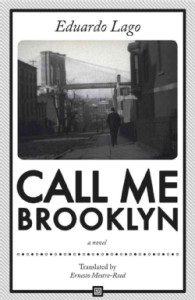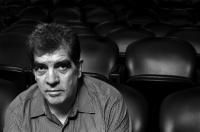
Seven years after winning Spain’s prestigious Premio Nadal, Eduardo Lago’s Call Me Brooklyn has finally been translated to English. Lago has translated authors ranging from Sylvia Plath to Junot Diaz, and his debut novel is a love letter to writers and their process. Call Me Brooklyn is a book for bibliophiles, a metatextual but wholly accessible exploration of authorial identities. Similar to Nabokov’s Ada or Ardor, Call Me Brooklyn is as much a story about its constellation of characters as it is a reflection on the very process of writing, combining journal entries and recreated scenes with letters and transcripts.
The novel opens with the death of Gal Ackerman, a Spanish-born New York writer who was adopted as a newborn by an American couple during the Spanish Civil War. Gal had been at work on an exhaustive memoir he intended to title Brooklyn, and when he dies it becomes the task of his friend Néstor to compile Ackerman’s notes and complete the book. Call Me Brooklyn, then, is as much Néstor’s story as it is Gal’s, and Lago challenges the reader to be invested not only in Gal’s storyline, but also the authorial process by which Néstor presents his friend’s life. A writer himself, Néstor sacrifices his own work to create a coherent narrative out of Gal’s notes, occasionally interjecting and apologizing to his deceased friend, and attempting to bridge Gal’s writings with the anecdotes he told Néstor and others at their neighborhood bar, the Oakland.
I read Call Me Brooklyn on the tails of Rachel Kushner’s The Flamethrowers and Renata Adler’s Speedboat, and just like these two astonishing novels, Call Me Brooklyn is a love story between a protagonist and his city. New York and the Oakland are Gal’s adopted homes, and similar to The Flamethrowers, a trip abroad only serves to highlight the protagonist’s allegiance to his city. Early in the novel, Néstor narrates Gal’s trip to Madrid, his birthplace. Gal’s discomfort in Spain stems from knowing that his birth was symbolic of a war he had no part in and a country where he does not belong. When he discovers that he is not the New Yorker he imagined, but rather the son of an unwed militia-woman and a father who is revealed as a traitor, Gal insists on his ambivalence, but is shaken by the revelations. He wanders through Madrid as a tourist, rejecting his adopted father’s hopes that he will experience an epiphany of belonging. Instead, he returns to New York and falls in love with Nadia, a woman he glimpses on a bus and then hires a detective to follow. Gal’s love affair with the elusive Nadia is his impetus to write his book: “I never knew why I did it, why I wrote it all down, but now I see that it makes sense—because of you. I’ve always wanted to write this book, this Brooklyn—even if I’m not sure what it will turn out to be, in the end. All I know is the real book is hiding underneath the thousands and thousands of words I can’t refrain from writing. I have to dig it up and give it a shape, so that you’ll read it.” Of course, with Gal’s death it becomes Néstor’s task to complete this book for a woman Néstor has never met, but who has figured heavily into Gal’s stories and writings.

Once Nadia disappears, Gal insists that he can still communicate not only with her, but with other pivotal characters from his past: his deceased birth parents, his anarchist grandfather who introduced him to Brooklyn’s secrets and history. Gal is both a conjurer of these memories and a vehicle through which these disparate characters interact, telling Néstor, “We always take a little bit away with us—from things, from places, from others. There are fragments, shreds of other beings that remain stuck in us like splinters. And it hurts, it hurts a lot, […] But that’s not what’s most important, what’s important is that they’re here now. I can hear their voices.”
While it’s a more traditional narrative than Speedboat, Call Me Brooklyn is also formally inventive and weaves seemingly unconnected anecdotes with a haunting, cumulative effect. I would recommend reading these two novels in conjunction with each other, allowing Adler’s precise narrative flatness to be complemented by Lago’s looser but equally astute and complex structure. With its interwoven texts and anecdotes, Call Me Brooklyn demands an active reader. In an interview with Carlos Rodríguez Martorell, Lago commented, “I want my novel to wink at intelligent readers; to tell them ‘you are my accomplices, my friends, let’s dive into this together.’ The best comment I’ve received from people is that, as they read the book, they have to suddenly ‘readjust’ themselves; they start reading it in one go but then realize that they can’t continue reading it like that. That is what I was looking for.” Call Me Brooklyn does requires a readjustment of sorts; the novel insists that readers examine a life that is not tidy or linear, but circular and full of doubts. Call Me Brooklyn is a reflection on how we actually live, and it pays homage to the writers and curators who thoughtfully and faithfully labor to draw meaning and cohesion from chaos.




